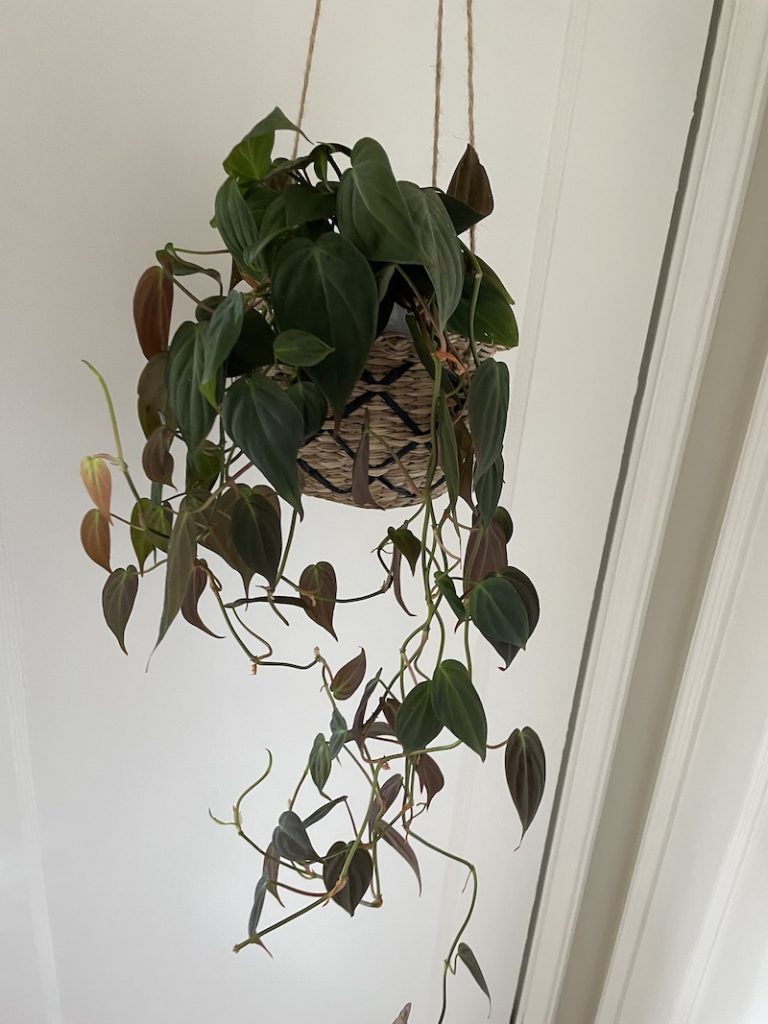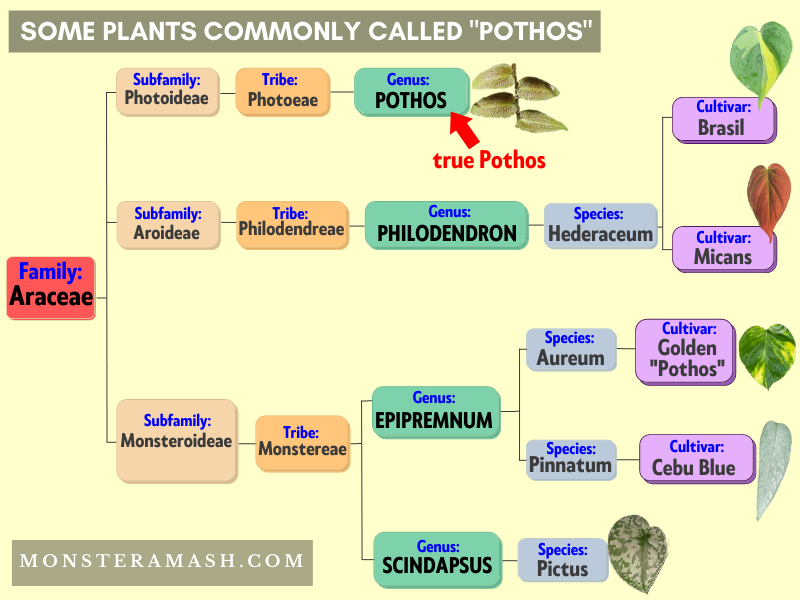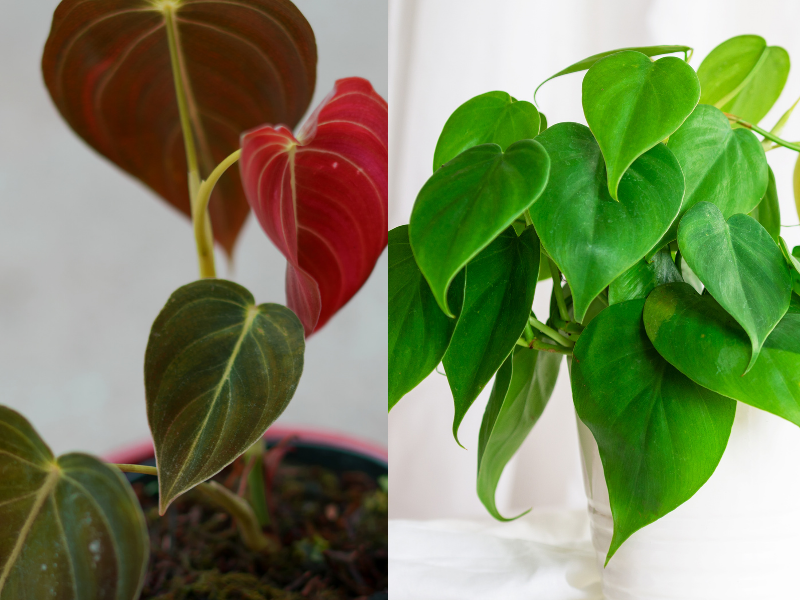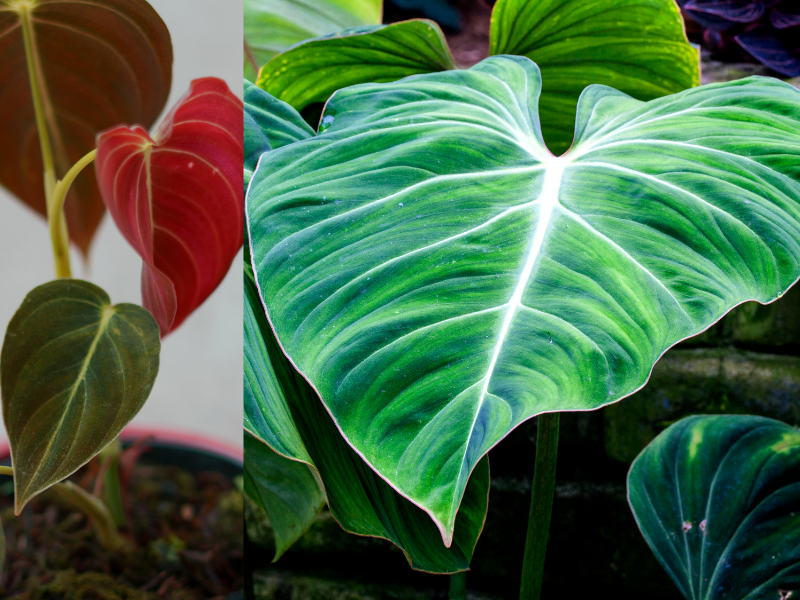Philodendron Micans is an exceptionally beautiful plant that does well in a variety of settings.
Known for its leaves which start off a velvety burgundy color and slowly turn to a royal green, P. Micans is one of the most elegant-looking Philodendrons that are on the common end of the spectrum.
While Philodendron Micans used to be considered rare, this is changing rather quickly, and you can now find P. Micans in a variety of places — including on Amazon!
Table of Contents
My Experience With Philodendron Micans

My Philodendron Micans couldn’t be easier to care for! It grows like a weed despite only getting medium to low light.
It is trailing beautifully — this is its growth after about 8 months, starting in a 4-inch nursery pot with barely any leaves cascading over the edge… and now look at it!
I had it in aroid potting mix for many months and recently switched it over to LECA.
I have given a number of cuttings to friends and I am always impressed by how fast it roots and takes off for them!
Where Can I Find Philodendron Micans for Sale?
There is a strong chance your local nursery will have Philodendron Micans! They are also showing up in more and more big box stores.
If you are having trouble finding it, you can also buy it on Amazon.
Philodendron Micans Overview and Origin

Philodendron Micans is well-loved among plant lovers for its soft, velvety texture. This popular house plant has dark green leaves lined by light green veins. On the underside of each leaf, you might find burgundy, red, and orange tones.
The official botanical name of Micans is Philodendron hederaceum. Interestingly, this species evolved to have countless “faces” or formas in nature. This led to 180+ years of name changes, reclassifications, and arguments among botanists who thought they were recording different species, but were really just looking at P. Hederaceum!
You might have heard of Micans being referred to as Philodendron scandens, Philodendron cordatum, or Philodendron oxycardium. Biologically, these are not distinct plants, but are simply synonyms of one accepted species.
In fact, even the famous yellow-variegated Philodendron Brasil is a variation of the Hederaceum species! In another article, we’ve written about P. Brasil and its many popular cultivars such as Rio, Gabby, Cream Splash, and Silver Stripe.
The parent species of Micans is native to Central America and South America. In the 1790’s, Captain William Bligh brought specimens of P. Hederaceum from the West Indies to the Royal Botanic Gardens in England.
Later on, cuttings were transported from England to Florida where the plant is now being cultivated on a large scale, and sold as indoor plants for everyone to grow.
Sometimes, you will hear Philodendron Micans and other Hederaceums being marketed as “Pothos” because they share the look of typical vining houseplants. If you check the chart above and this Epipremnum article we’ve written, you’ll know what Pothos plants exactly are!
Philodendron Micans vs. Heartleaf Philodendron

Both Philodendron Micans and the Heart leaf Philodendron are naturally-occurring forms of the same species – Philodendron Hederaceum. Micans has reddish undersides and a velvety texture, while Heartleaf Philodendron has solid green, glossy leaves.
Heart-leaf Philodendron also goes by the name Sweetheart Philodendron or Sweetheart Plant. Its botanical name is Philodendron hederaceum var. Oxycardium. You can readily find Heartleaf Philodendron plants in homes and garden shops all over the world.
One common name that is often associated with Micans is “P. Scandens”. This name is being used interchangeably for both Micans and Heartleaf Philodendron.
Nevertheless, it is important to note that the Hederaceum species and aroids in general are highly variable. Each species can develop many different forms according to the varying conditions where they grow.
Think of it like humans. Despite having distinct skin colors and physical features, Asians, Caucasians, Africans, etc. are not labelled as “related species”. Instead, we all fall under one species: the Homo sapiens!
We’ve prepared a table to demonstrate how Philodendron Micans got its many names. These are the scientifically-accepted names of Philodendron Hederaceum as recognized by the IPNI, POWO, and ITIS:
| OFFICIAL SPECIES NAME: Philodendron hederaceum (Jacq.) Schott |
| Accepted Synonyms of the Species: •Arum hederaceum Jacq. •Pothos hederaceus (Jacq.) Aubl. |
| Accepted Variety #1: Philodendron hederaceum var. hederaceum (Jacq.) Schott Common Name: “Vilevine” Synonyms of this Variety: •Philodendron micans Klotzsch ex K. Koch •Philodendron micans var. brevipes Engl. •Philodendron micans var. microphyllum (K.Koch) Engl. •Philodendron scandens f. micans (Klotzsch ex K.Koch) G.S.Bunting •Philodendron scandens K. Koch & Sello •Philodendron scandens ssp. scandens K. Koch & Sello •Philodendron scandens ssp. isertianum (Schott) G.S. Bunting •Philodendron scandens subsp. cubense (Engl.) I.Arias •Philodendron scandens var. cubense Engl. •Philodendron scandens var. cuspidatum (K.Koch & C.D.Bouché) Engl. •Philodendron scandens subsp. prieurianum (Schott) G.S.Bunting •Philodendron acrocardium Schott •Philodendron cuspidatum K.Koch & C.D.Bouché •Philodendron harlowii I.M.Johnst. •Philodendron isertianum Schott •Philodendron microphyllum K.Koch •Philodendron miduhoi Matuda •Philodendron oxyprorum Schott •Philodendron pittieri Engl. •Philodendron prieurianum Schott •Philodendron scaberulum C.Wright •Philodendron subsessile Gleason |
| Accepted Variety #2: Philodendron hederaceum var. oxycardium (Schott) Croat Common Name: “Heartleaf Philodendron” Synonyms of this Variety: •Philodendron scandens ssp. oxycardium (Schott) G.S. Bunting •Philodendron oxycardium Schott |
| Accepted Variety #3: Philodendron hederaceum var. kirkbridei Croat Synonyms of this Variety: none recorded |
Philodendron Micans Juvenile vs. Mature Leaves

The Philodendron Micans starts with juvenile plants having small leaves, a velvety texture, and shades of red. Eventually, the mature plants will grow to have larger leaves, a dark green color, and robust, heart-shaped leaf blades.
You might often see P. Micans being sold in a hanging basket, but please note that allowing the stems of your plant to trail down without support will lead to new leaves emerging smaller and smaller after a long time.
Like most climbing Philodendrons, the Philodendron Micans will start to grow bigger leaves when you give it a moss pole or any structure to climb on. For best results, keep the pole moist so the aerial roots can cling faster.
The growth progression of Micans leaves from juvenile to mature is demonstrated in this single photo from Reddit. When you compare the leaf shapes of the baby specimens and their adult counterparts, they almost look like they come from completely different plants!
I’ve seen many claims that the Philodendron Micans will eventually lose its velvety texture as it grows bigger. However, someone on Reddit was able to photograph a mature velvety Micans growing in its natural habitat!
Philodendron Micans Care Guide
The Philodendron Micans is a tropical plant that is notably easy to care for. You can let this evergreen perennial vine trail down beautifully from hanging pots, or you can let it climb up walls and shelves for an indoor jungle vibe.
The best thing about Philodendrons is you can pretty much neglect them for long periods as long as they have a moisture-retaining but fast-draining potting mix to keep the roots hydrated.
Common disease problems for the Philodendron Micans include root rot, spider mites, and fungus gnats. The best ways to deter these pests are consistent watering, proper soil drainage, and a monthly spray of diluted neem oil.
Philodendron Micans Light Needs
Philodendron Micans is a hardy plant that will grow in a variety of lighting conditions. It can grow well in medium indirect light, but putting your Micans near a window with access to bright indirect light will result in bigger leaves and faster growth.
In the wild, Philodendron Hederaceum receives dappled sunlight passing through the thick rainforest canopy. Make sure you don’t expose your houseplant to extended periods of direct sunlight. Otherwise, you might find bleached white leaves or crispy brown edges.
P. Micans has a tendency to get thinner with bald spots on top as the vines cascade towards the side of the pot. In fact, Micans can grow more leggy than other varieties of P. Hederaceum. This usually means your plant is receiving too little light from the top down.
To increase lighting, install LED grow lights or move your plant closer to a bright windowsill. To decrease lighting, use curtains to filter the light coming in. Whichever is the case, remember to acclimatize your plant before permanently moving it to a new lighting setup.
Philodendron Micans Watering Needs
The Philodendron Micans is particularly sensitive to both overwatering and underwatering. This plant has a high moisture requirement, so it’s best to keep it in moist soil at all times.
When the top half of the soil feels dry to the touch, pour plenty of water over the pot. To flush out mineral salts and to deeply nourish the roots, keep pouring until you see excess water flowing out of the drainage holes.
You may need to water your Philodendron Micans more frequently if it’s planted in a pot made of terracotta, unglazed ceramic, or concrete. These porous materials will pull moisture away from the soil.
Other factors that will require you to increase your watering schedules are warmer temperatures, higher light exposure, and dry air.
Conversely, you will need to reduce your watering schedules in the winter seasons. During those months, plant roots are less active in taking up water, plus there’s not enough sun exposure to dry the soil.
Philodendron Micans Soil Needs
A well-aerated, fast-draining soil mix is ideal for your Philodendron Micans. However, it also needs to be able to retain just enough moisture to keep the roots hydrated at all times. A peat-based mix will usually suffice.
To allow the roots to breathe and to prevent fungal diseases, your potting soil will need gritty and chunky components. You can choose to add coco cubes, wood chips, horticultural coal, perlite, pumice, river sand, orchid bark, or vermiculite.
Of course, you will also need components that are rich in nutrients and are able to retain water. These include sphagnum moss, coconut coir, worm castings, garden compost, and animal manure.
If you need help deciding which components to choose, check out our DIY Aroid Soil Mix recipe!
Philodendron Micans Temperature & Humidity Needs
Native to tropical America, Philodendron Micans will thrive in warm areas in your home with high humidity. For optimal growth, maintain a minimum temperature of 65ºF and a humidity level of at least 40%.
To increase humidity for your Philodendron Micans, you can place its pot over a tray of pebbles with water. You also can group your houseplants together in a humidity bubble. For a steady stream of damp, moist air, your best bet is to invest in a humidifier.
Philodendron plants are sensitive to the cold. Temperatures below 55ºF can shock the roots of your Micans, so make a note to close windows and avoid chilly drafts in the colder months.
On the other hand, excessive heat can dry the leaves of your P. Micans. Keep your plant away from direct sources of heat indoors such as appliances, vents, and fireplaces.
Philodendron Micans Fertilization Needs
A balanced NPK fertilizer will benefit your Philodendron Micans on a monthly basis, depending on how fast your plant is growing. Cut the strength of the solution in half to avoid fertilizer burn.
The active growing season of Philodendron Micans starts in the early summer. At this time, your plant will shoot out new leaves at a faster rate, so it will need plenty of plant food to replenish the energy it uses to grow.
Choose a product that has both macronutrients (Nitrogen, Phosphorus and Potassium) and micronutrients (Boron, Zinc, and Manganese).
Fertilizers can be powdered, liquid, or pellet-sized. Whichever you choose, follow the mode of application and the recommended dosage as written on the product label.
During the winter months, your Philodendron Micans will have a slow growth and won’t be needing as much fertilizer as it does in warmer weather.
Pruning Philodendron Micans
As a prolific grower, Philodendron Micans will need constant pruning to manage its size and overall look. Cutting back the older leaves and the long leggy stalks of your Philodendron Micans will encourage new growth points.
Pluck off any yellow leaves and brown leaves as you see them. Pests are especially attracted to unhealthy parts of a plant. By plucking off unhealthy foliage, you will help your plant focus its energy on growing new, green leaves.
To avoid bacterial and fungal infections, disinfect your gardening tools with alcohol before making any cuts on your Philodendron. Treat fresh cuts with cinnamon powder or hydrogen peroxide if you have these products at home.
Propagating Philodendron Micans
Here are 3 propagation methods for your Philodendron Micans:
1. Soil propagation: Take a cutting with at least one leaf node. Without a node, your cutting can never grow new leaves! Dip the cutting in rooting powder to encourage faster rooting. Then, plant it in a sterile potting mix and water the soil. Keep the new plant in a bright shaded area until it develops roots. Extra humidity will help with faster rooting!
2. Water propagation: You can simply let stem cuttings sit in a clear glass of water and wait for them to develop roots. You will need to replace the water when it turns murky. A few drops of hydrogen peroxide will oxygenate the growing roots and kill off microbes. Once you are happy with the length of the new roots, plant the cutting in soil.
3. Perlite box: Fill a plastic box or a Ziploc bag halfway with moist perlite. Place the cuttings on top and bury its nodes in perlite. Check the cuttings after 2-3 weeks to see if they have enough roots to be potted in soil.
Repotting Philodendron Micans
Philodendron Micans will need to be repotted once a year on average, or however long it takes to become root-bound. Ideally, you should repot your plant in springtime when the mild weather allows for faster recovery.
If your Micans’ leaves are drying up quickly despite frequent watering, that might be an indication that the roots have overwhelmed the pot. To confirm, check if you can see roots poking out of the drainage holes.
When repotting your plant, choose a pot about twice as deep and wide as the old one. Make sure there are drainage holes to avoid root rot.
Try not to disturb the main rootball while transplanting your Micans. Replenish the old soil with a new batch. Finally, avoid applying any fertilizers or chemical treatments while the roots are still sensitive from being transplanted.
Philodendron Micans FAQ
Now that you know how to care for your Philodendron Micans, we’re sharing more tips and tricks about this plant’s behavior based on the growing successes of other plant parents.
How do you get dark leaves on Micans?
You can get darker leaves on your Philodendron Micans with the right amount of low light exposure. Plants with a deep, dark green color such as P. Micans are already able to store a lot of chlorophyll in their leaves, so they don’t need too much light.
Start by moving your Micans away from sources of bright light such as windows or grow lights. Then, remember to reduce your watering and fertilization. In partial shade, your plant won’t be using up as much water and energy to grow.
Why is my Philodendron Micans turning orange or red?
The leaves of your Philodendron Micans will turn orange, red, or maroon when exposed to a lot of bright light. Although reddish Micans are considered healthy plants, be aware that exposing them to too much direct sunlight can burn their leaves.
I’ve also seen variegated Micans in shades of pink and cream which you can check out here and here!
How do you get big leaves on Philodendron Micans?
Your Philodendron Micans will grow big, mature leaves when you give it a moss pole, a wooden plank, a bamboo stick, a trellis, or any structure for support. Mist the pole once a day to help this evergreen climber cling faster.
As a climbing plant, the aerial roots of the Micans will latch onto any available support so it can grow upwards to reach for more light. Once the plant has secured a vertical position, it gets the signal that it’s allowed to produce bigger, wider leaves.
You can also increase the air humidity in the room or move your plant to a brighter location to help the leaves grow into their fully matured form.
How do you make Philodendron Micans bushier?
To encourage bushy growth on your P. Micans, it is important that you provide the ideal conditions for this plant. Higher humidity, frequent pruning, and plenty of light will lead to lusher foliage.
As observed by many owners of this plant, the Philodendron Micans has a tendency to grow long, leggy stalks with few, tiny leaves in between. When that happens, simply chop off the stalks for propagation then stick them back into the same pot for a fuller look.

Eliza is a writer and a plant hobbyist from the tropical country of the Philippines. She views gardening as an art, but she has made it her mission to learn the scientific aspect of anything that grows on Earth.
